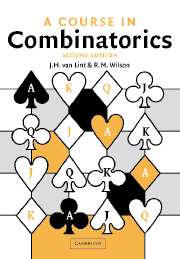Book contents
- Frontmatter
- Contents
- Preface to the first edition
- Preface to the second edition
- 1 Graphs
- 2 Trees
- 3 Colorings of graphs and Ramsey's theorem
- 4 Turán's theorem and extremal graphs
- 5 Systems of distinct representatives
- 6 Dilworth's theorem and extremal set theory
- 7 Flows in networks
- 8 De Bruijn sequences
- 9 Two (0, 1, ⋆) problems: addressing for graphs and a hash-coding scheme
- 10 The principle of inclusion and exclusion; inversion formulae
- 11 Permanents
- 12 The Van der Waerden conjecture
- 13 Elementary counting; Stirling numbers
- 14 Recursions and generating functions
- 15 Partitions
- 16 (0, 1)-Matrices
- 17 Latin squares
- 18 Hadamard matrices, Reed–Muller codes
- 19 Designs
- 20 Codes and designs
- 21 Strongly regular graphs and partial geometries
- 22 Orthogonal Latin squares
- 23 Projective and combinatorial geometries
- 24 Gaussian numbers and q-analogues
- 25 Lattices and Möbius inversion
- 26 Combinatorial designs and projective geometries
- 27 Difference sets and automorphisms
- 28 Difference sets and the group ring
- 29 Codes and symmetric designs
- 30 Association schemes
- 31 (More) algebraic techniques in graph theory
- 32 Graph connectivity
- 33 Planarity and coloring
- 34 Whitney Duality
- 35 Embeddings of graphs on surfaces
- 36 Electrical networks and squared squares
- 37 Pólya theory of counting
- 38 Baranyai's theorem
- Appendix 1 Hints and comments on problems
- Appendix 2 Formal power series
- Name Index
- Subject Index
23 - Projective and combinatorial geometries
Published online by Cambridge University Press: 05 June 2012
- Frontmatter
- Contents
- Preface to the first edition
- Preface to the second edition
- 1 Graphs
- 2 Trees
- 3 Colorings of graphs and Ramsey's theorem
- 4 Turán's theorem and extremal graphs
- 5 Systems of distinct representatives
- 6 Dilworth's theorem and extremal set theory
- 7 Flows in networks
- 8 De Bruijn sequences
- 9 Two (0, 1, ⋆) problems: addressing for graphs and a hash-coding scheme
- 10 The principle of inclusion and exclusion; inversion formulae
- 11 Permanents
- 12 The Van der Waerden conjecture
- 13 Elementary counting; Stirling numbers
- 14 Recursions and generating functions
- 15 Partitions
- 16 (0, 1)-Matrices
- 17 Latin squares
- 18 Hadamard matrices, Reed–Muller codes
- 19 Designs
- 20 Codes and designs
- 21 Strongly regular graphs and partial geometries
- 22 Orthogonal Latin squares
- 23 Projective and combinatorial geometries
- 24 Gaussian numbers and q-analogues
- 25 Lattices and Möbius inversion
- 26 Combinatorial designs and projective geometries
- 27 Difference sets and automorphisms
- 28 Difference sets and the group ring
- 29 Codes and symmetric designs
- 30 Association schemes
- 31 (More) algebraic techniques in graph theory
- 32 Graph connectivity
- 33 Planarity and coloring
- 34 Whitney Duality
- 35 Embeddings of graphs on surfaces
- 36 Electrical networks and squared squares
- 37 Pólya theory of counting
- 38 Baranyai's theorem
- Appendix 1 Hints and comments on problems
- Appendix 2 Formal power series
- Name Index
- Subject Index
Summary
A combinatorial geometry is a pair (X, ℱ) where X is a set of points and where ℱ is a family of subsets of X called flats such that
ℱ is closed under (pairwise) intersection,
there are no infinite chains in the poset ℱ,
ℱ contains the empty set, all singletons {x}, x ∈ X, and the set X itself,
for every flat E ∈ ℱ, E ≠ X, the flats that cover E in F partition the remaining points.
Here, F covers E in F means that E, F ∈ ℱ, but that does not hold for any G ∈ ℱ. This latter property should be familiar to the reader from geometry: the lines that contain a given point partition the remaining points; the planes that contain a given line partition the remaining points.
A trivial example of a geometry consists of a finite set X and all subsets of X as the flats. This is the Boolean algebra on X.
We remark that (1) and (2) imply that ℱ is closed under arbitrary intersection.
Example 23.1. Every linear space (as introduced in Chapter 19) gives us a combinatorial geometry on its point set X when we take as flats φ, all singletons {{x} : x ∈ X}, all lines, and X itself. The fact that the lines on a given point partition the remaining points is another way of saying that two points determine a unique line.
- Type
- Chapter
- Information
- A Course in Combinatorics , pp. 303 - 324Publisher: Cambridge University PressPrint publication year: 2001

